|
|
BIBLIOGRAPHY
Censorship in contemporary art?
To give an answer to the question of censorship in contemporary art, one has to go back to modernist tradition. Contemporary art is deeply rooted in aesthetic and poetic of historical
avant-garde, with a difference: Historical avant-garde, looking forward on the idea of progress, refused tradition, while nowadays is considered avant-garde the part of contemporary art that looks back and make use of languages, tools and strategies developed in the first decade of
the past century.
In February 1909, the Italian poet Filippo Tommaso Martinetti published The Futurist Manifesto in the French newspaper Le Figaro. The Futurist Manifesto glorified militarism and war
-the world’s only hygiene- and aimed to fight moralism and destroy museums, libraries, and academies of every kind.
In the Futurist manifesto, Marinetti declares: - …. Museums: cemeteries… …Admiring an old picture is the same as pouring our sensibility into a funerary urn instead of hurtling it far off, in violent spasms of action and creation.- Do you, then, wish to waste all your best powers in this eternal and futile worship of the past, from which you emerge fatally exhausted, shrunken, beaten down?...-.
Hundred years after, the anniversary is celebrated in the most important European museums from Le Scuderie del Quirinale in Rome (1) to Tate Modern in London, from Palazzo Reale in Milan to Centre Pompidou in Paris and it is quite amazing to read the words of Marinetti and notice how Futurism has been swallowed in the Art-Museum System that it was intended to destroy.
(1)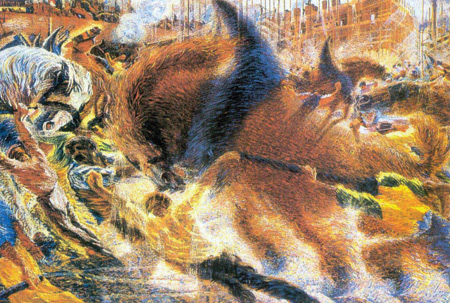
Umberto Boccioni
“La città che sale” (The raising town), Oil on canvas, cm.199 x 301. 1910-11.
In XIX century, the largest act of censorship in visual art was carried out through a…Art Exhibition! The official Nazi exhibition of Entartete Kunst (Degenerate Art) in Munich, July 1937, was designed to ridicule and denigrate creative works not upholding "correct" National Socialist virtues (2).
In Munich alone two million people visited this exhibition.
(2)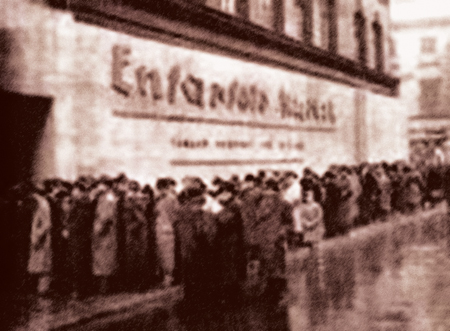
Fabrizio Ruggiero
Entartete Kunst (Degenerate Art) cm.32 x 43, Limited print edition of 10. 2009
On March 1939, the Degenerate Art Commission ordered over one thousand paintings to be burned in the courtyard of a fire station in Berlin.
After Second World War till early 80’ the art scene in Europe was dominated by an art based on the language of American art of the 40’.What shape took censorship during this period?
In the 50’s the most influent art critics were Clement Greenberg and Harold Rosenberg both of Jewish origin, a non figurative culture. In December 1950 Clement Greenberg joined the CIA fronted American Committee for Cultural Freedom. In cold war context Greenberg, with CIA huge funding, promoted Abstract Expressionism as the basis for Cultural Propaganda that the USA had become the guardian of 'Advanced Art'. Harold Rosenberg coined the term Action Painting in his essay "American Action Painters" (ARTnews, December 1952). The ambiguous title both refer to American Action Painters and Post Painterly Abstraction and reveals Rosenberg's political agenda in crediting USA as the center of international culture.
Only in the 70’ art exhibitions assumed the privileged character of sense-maker and the Contemporary Art System started to take shape.
Later on become predominant "Pensée unique”, the cultural hegemony of neoliberalism as an ideology in the late twentieth century, an enforced reduction in political discussion by mainstream politics as in the famous populist TINA-Argument ("There Is No Alternative") of Margaret Thatcher and The Art System started to be Market -Orientated.
With the fall of Berlin wall, ideologies come to an end, apart from the “Market” one.
Even the Art System become fully structured and market –orientated.
The elements of the Art System are artists, critics, galleries, curators, museums and collectors. When these single entities are linked each other, the art system is ready for the creation of” Value”, not only the artistic but also the monetary one.
In this trend exhibitions assume the privilege of sense-maker and artworks become “words” of a “statement” conceived by a curator. Through this process curators assume a role never seen previously. They become not only specialized personnel with a historical-artistic formation but teoricians, organizers and “authors” as in the Foucault* statement:-Author does not precede the work, he is a functional principle limiting, excluding, choosing, It is a means through which the free circulation, free manipulation free composition, decomposition and re-composition of real is censored and banned for the achievement of the proposed thesis-..
Supplementary formats like catalogues, magazines, reviews etc grow in importance with the raise of Art System. The framework of supplementary formats adds a certain aura or mythic value to artworks so as their exhibition in museum and galleries adds value to artworks itself. Financial institutions, banks, insurance company become partners and sponsors of museums as well as art collectors. At times the mix generates even insider trading, like in The Upper Room (3), an installation of 13 paintings of monkeys by artist Chris Ofili. It was bought by the Tate gallery and was the cause of a media furor after a campaign initiated by the Stuckist art group, as Ofili was on the board of Tate trustees at the time of the purchase. In 2006 the Charity Commission censured the Tate for the purchase, but did not revoke it.
(3)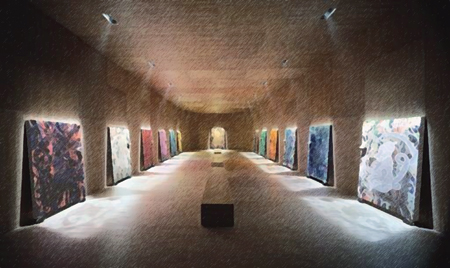
Fabrizio Ruggiero
Inner view of “The Upper Room” cm. 50 x 30 Print from Watercolour
Limited edition of 10. 2009.
In 2009 Venice Biennale the more surprising decisions has been the selection of Liam Gillick, an English artist, to occupy the German pavilion. Walter Bornsen, culture spokesman for the German Christian Democrat party, condemned the decision. The selection of Gillick was made by German Pavilion curator Nicolaus Schafhausen, that curated Gillick’s mid-career retrospective at Witte de With Center for Contemporary Art in Rotterdam last year.
Another interesting controversial is about a sculpture of Charles Ray, at Punta della Dogana, one of the most scenic places in Venice. The sculpture is exhibited as part of the personal collection of a fashion tycoon, François Pinault who got the place for free on a long tem loan. According to Charles Ray the sculpture, Boy with a frog (4), was inspired by the reading of a Mark Twain description of Mississippi river. Most people thought the right location was near Mississippi bank, but what to do with Venice??
(4)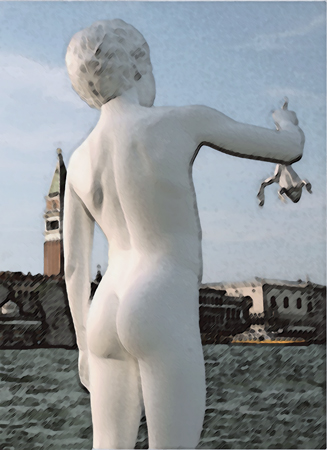
Fabrizio Ruggiero
Venice, View of Campanile di San Marco from Punta della Dogana with the Boy with frog sculpture of C. Ray
cm, 32 x 44 Print from Watercolour Limited edition of 10, 2009
Many more noticed that the subject is a very common one for XIX century fountains…. (picture5).
/5)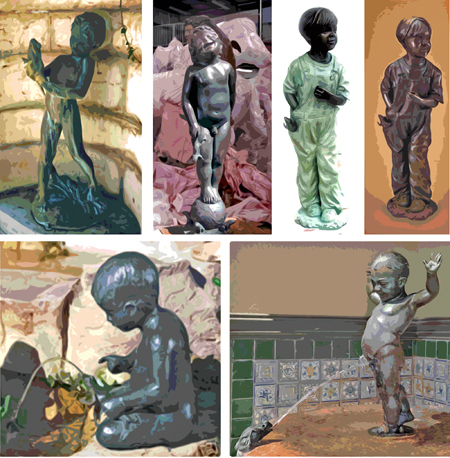
Some lovers noticed a reminiscence of Donatello’s David…. (6)
(6)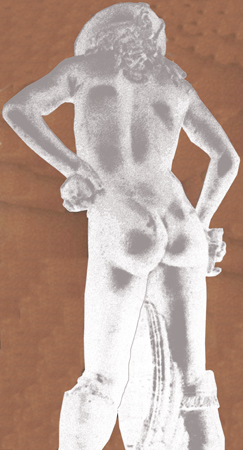
Fabrizio Ruggiero
View of Donatello’s David in Bargello Museum
Cm. 30 x 54 Print from Watercolour
Limited edition of 10. 2009.
In contemporary art and in a globalised world the distinction between art and fashion becomes cloudy…and in this way art risks to loosen its function. Fashion is concerned with the appearance of reality and works on the surface of existence. The search of what is behind the continuous fluxus of appearance has always been the purpose of Art.
Unity and interdependence of all phenomena and Universe as continuous fluxus void of reality have always been fundamental themes in true art.
As people interested in art we should be concerned at what happens in the world, the violence, brutality, wars, dishonesty in the high ranks of politics.
All our conditionings, all our activities are based on thought, what is the nature of though, then?
Is thought a movement? Is thought memory stored in the brain as experience and knowledge? The answer to all demands of life comes from experience stored in the brain as knowledge and this answer is again thought!
Thought being fragmentary cannot grasp what is WHOLE.
Art as Truth is a pathless land.
In this way art cannot be affected by authority and censorship, but there is the risk that people endowed with authority can censor the visibility of art according to their personal interest.
Fabrizio Ruggiero
NUKTA ART MAGAZINE 2009
|
![]()